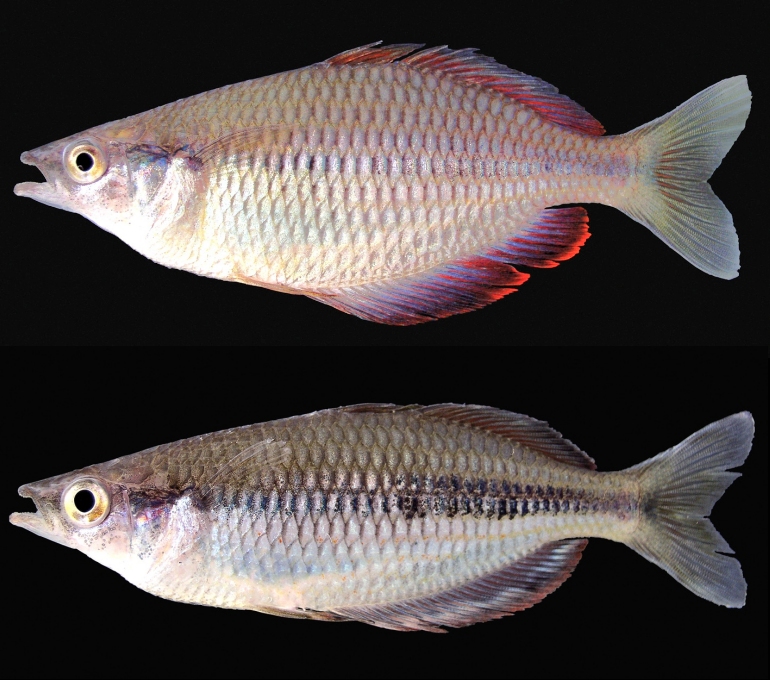|
 |
Melanotaenia veoliae (∧ male ∨ female) © B. Dwisusilo |
Kadarusman, Caruso & Pouyaud, 2012
Veolia Rainbowfish
Species Summary
The colour of mature males is grey-pink on upper back; body scales with narrow brown outline; lower half of side of body and belly whitish; a diffuse dark-pink blotch immediately behind eye on uppermost part of operculum; a large blue patch directly above abdomen and behind pectoral fin; lateral flanks with six or seven grey stripes, corresponding with horizontal scale rows, the first stripe directly above the midlateral line sometime intense, stripes below the midlateral line faint; a dark midlateral stripe of one scale wide extending from upper edge of preopercle to caudal-fin base; pectoral and caudal fins translucent; dorsal and anal fins blood red with soft rays azure blue. Overall colour of females is similar but paler than males.
Similar to many Melanotaenia, mature males are deeper bodied than females (35-38 vs. 31-34% SL) and have a more elongate and pointed shape posteriorly on the soft dorsal and anal fins. The longest soft dorsal-fin rays of males are located in the posteriormost portion of the fin, in contrast to that of females, which are situated in the anterior half of the fin. Depressed posterior tip of the dorsal fin extends about two-thirds of caudal peduncle for males and only one half for the females. In addition, the depressed posterior tip of anal fin extends about one half of caudal peduncle for males and only one third for the females. The species was named veoliae, in honour of the Foundation Veolia Environment which sponsored among others the Lengguru-Kaimana Expedition in October-November 2010.
Melanotaenia veoliae is related to the species occurring on the Bomberai Peninsula and on the Bird's Head Peninsula (Vogelkop or Doberai Peninsula) of far western New Guinea. The Bird's Head Peninsula forms the north-western end of the island of New Guinea. To the east is Cenderawasih Bay and to the south Bintuni Bay. To the west, across the Dampier Strait is Waigeo Island, and Batanta Island lies just off the northwest tip. The peninsula south is Bomberai Peninsula.
Distribution & Habitat
Melanotaenia veoliae is currently known only from the type locality, a karst resurgence emerging from the north side of the Kaimana Anticline. Gebiasi Creek is a typical fragmented hydrologic system in a karstic environment. The creek emerges from a karstic cave then flows on about 60 metres before disappearing in a subterranean outlet. This aerial river segment is the home of Melanotaenia veoliae. The creek reappears in the mangroves after 200 metres underground from a small cave and flows to the Arguni Bay, 7 km east of Syirnusu Island. The type locality (altitude 40 m) consists of a blue and crystalline stream, narrow (to about 2-3 metres wide), relatively shallow (up to about 1 metre) and flowing in primary forest.
Remarks
Specimens of Melanotaenia veoliae were collected in November 2010 during the Lengguru-Kaimana Expedition led by Balai Riset Budidaya Ikan Hias in Depok, Indonesia (BRBIH-KKP), the Akademi Perikanan Sorong, Indonesia (APSOR-KKP), the Lembaga Ilmu Pengetahuan Indonesia (LIPI) and by the Institut de Recherche pour le Développement Montpellier, France (IRD).
Literature
Kadarusman, R.K. Hadiaty, G. Segura, G. Setiawibawa, D. Caruso & J. Pouyaud (2012) Four new species of Rainbowfishes (Melanotaeniidae) from Arguni Bay, West Papua, Indonesia / Quatre nouvelles espèces de poissons arc-en-ciel (Melanotaeniidae) de la baie d'Arguni en Papouasie occidentale, Indonésie. Cybium, 36(2): 369-382.
Adrian R. Tappin
July, 2012



|
|

